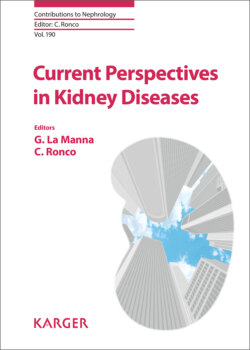Читать книгу Current Perspectives in Kidney Diseases - Группа авторов - Страница 31
На сайте Литреса книга снята с продажи.
RCA and Circuit Life Span
ОглавлениеThe circuit life span is affected by many factors, such as the patient’s clinical condition, coagulation status, patency of vascular access, modality of CRRT, and filtration fraction. The various confounding factors may cause a high heterogeneity among trials but the recent meta-analysis by Liu et al. [10] suggested that the choice of anticoagulant between heparin and citrate may play a pivotal role. In particular, RCA may have an advantage in prolonging the circuit life span. Thirteen trials that investigated the circuit life span of citrate versus heparin groups during CRRT were taken into consideration. The circuit duration before clotting was significantly longer in the citrate group than in the heparin group, with a mean difference (MD) of 15.69 h (95% CI 9.30–22.08, p < 0.01). Due to the remarkable heterogeneity mentioned above, subgroup analyses were performed by the authors studying CVVH, CVVHDF, pre-dilution, and post-dilution groups separately. Overall, in the CVVH (MD 8.18, 95% CI 3.86–12.51, p < 0.01) and pre-dilution subgroups (MD 17.51, 95% CI 9.85–25.17, p < 0.01), the circuit life span was significantly longer in the citrate group than in the heparin group [10].
In our experience (we started using citrate in 2010), in the 5 years from 2011 to 2015, we performed a total of 7,316 twenty four hour-treatments (CRRT) with a progressively increasing proportion of treatments using RCA (from 2.9% in 2011 to 49.5% in 2015). We observed a progressive reduction in the number of filters used for every 72 h of treatment (from 2.4 in 2011 to 1.3 in 2015). Although we did not directly collect these data, because the analysis is retrospective, we are in agreement with the reports by authors (Schilder et al. [18]) that one can assume a longer filter duration.
In any case, the circuit life span cannot be considered a positive aim per se, since we should not forget that membrane depurative performances reduce over time. For example, in 2 small trials [17] the authors obtained a median circuit lifetime of 70 and 124 h, respectively during CRRT with RCA. Even though, in the first of these 2 studies, Monchi et al. [16] noted that after 96 h the sieving coefficient for β2-microglobulin was higher than 0.8, it is commonly accepted that such a long filter life span is not the target. What happens in the first 48–72 h is more interesting to understand.
Schilder et al. [18] showed that the down-time (the time when the treatment does not work) within 72 h was less with citrate (1 h for RCA vs. 3 h for heparin, p = 0.002), as were the number of filters used (1 for RCA vs. 2 for heparin, p = 0.002). There was a higher incidence of circuit disconnection due to clotting of the circuit in the heparin group (51 vs. 24% in the citrate group) and more elective filter changes in the citrate group (30 vs. 9% in the heparin group, p = 0.01). Both Morabito et al. [12] and Stucker et al. [19] showed from similar data that increased filter lifespan with RCA means less treatment interruption and more effective dialysis. These authors confirmed that, starting from the same prescribed dose, the effective delivered daily CRRT dose was higher in the RCA group than in the heparin group in accordance with the well-known concept that the so-called “down-time” is one of the most important determinants of good correspondence between prescribed and delivered doses in CRRT [20].
Our data are consistent with these observations. In fact, in increasing the percentage of treatment using citrate as an anticoagulant (in 2011: no anticoagulation 59.1%, heparin 37.8%, RCA 2.9% of CRRT; in 2015: no anticoagulation 27%, heparin 23.4%, RCA 49.5% of CRRT), the discrepancy between the prescribed and delivered dialysis doses decreased from 22.3% in 2011 to 7% in 2016 (Fig. 2; personal data, not published).
